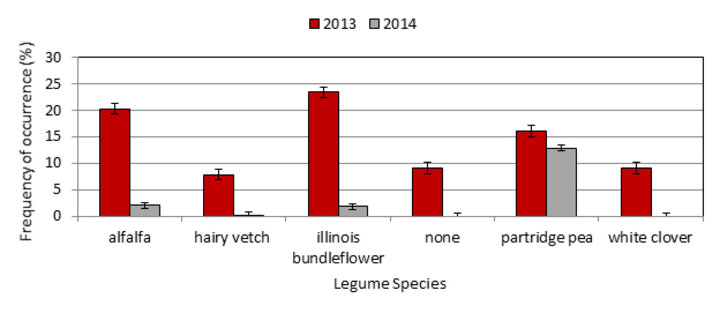Major Findings
- Legume establishment was greatest at a 24-inch row spacing.
- Legume establishment was greater in Liberty switchgrass than Shawnee switchgrass at narrower row spacings.
- Illinois bundleflower was easiest to establish, followed by alfalfa and partridge pea.
- Partridge pea was the most resilient legume.
Why is This Important
Inter-seeding legumes into grass pastures can reduce nitrogen fertilizer inputs and increase plant biodiversity.
Switchgrass (Panicum virgatum L.) is a highly productive, native perennial grass broadly adapted to growing conditions east of the Rocky Mountains. Switchgrass can be used for biofuel, grazing, and hay on land that is typically considered marginally productive for annual crops. In native grass stands, inter-seeding legumes has been suggested as a management practice to reduce nitrogen fertilizer inputs and increase biodiversity.
Legumes often do not compete well for light, water, and nutrients. Thus, inter-seeding legumes into well-established grass stands has proven difficult, but minimal information exists regarding altering switchgrass row spacing. Few planting recommendations exist for consistent legume establishment in native grasses. The goal of this study was to assess the effect of switchgrass row spacing for improving the establishment and persistence of five legume species.
What Did We Do?
This project was conducted from 2010 to 2015 and evaluated the effect of switchgrass row spacing on the establishment of Illinois bundleflower [Desmanthus illinoensis (Michx.) MacMill. ex B.L. Rob. & Fernald], partridge pea [Chamaecrista fasciculata (Michx.) Greene], alfalfa (Medicago sativa L.), white clover (Trifolium repens L.), and hairy vetch (Vicia villosa Roth). A no-legume control was included to evaluate the effect of row spacing on biomass yield. The first two years of the study were considered establishment years and data from these years were not analyzed.
Two switchgrass strains were used in this study: ‘Shawnee’, an upland ecotype, and ‘Kanlow x Summer HP1 NETO2 C1’, an experimental lowland ecotype later released as ‘Liberty’. Switchgrass was seeded at 30 PLS ft2 using a no-till drill and seeded at 6-, 12-, 18-, 24-, 30-, and 36-inch row spacings. Legumes were seeded as monocultures at 30 PLS ft2 using a no-till drill in 6-inch rows perpendicular to the switchgrass rows soon following switchgrass seeding. Switchgrass and legume stands were evaluated using frequency grids throughout the growing season to determine establishment success and persistence (Figure 1).
What Did We Learn?


Legumes planted into Liberty (lowland ecotype) had greater establishment and persistence than legumes seeded into Shawnee (upland ecotype) (Figure 1). Although Liberty had greater legume frequency of occurrence throughout the study, increasing switchgrass row spacing from 6 up to 36 inches did not improve legume establishment or persistence. However, legume establishment with Shawnee increased as row spacing increased from 6 to 24 inches.
Of the five legumes evaluated, Illinois bundleflower had the greatest establishment success, followed by alfalfa, then partridge pea. Partridge pea did well in both the dry year (2013) and the year with near-normal precipitation (2014) and was considered the most resilient legume, especially during the dry year.
So What?
Establishing legumes with switchgrass and maintaining them in the stand for the long-term is difficult. Legume persistence remains an important factor for further research. Planting a highly competitive legume species, such as Illinois bundleflower or alfalfa, is an important consideration. Based on results from this study, row spacing only affected legume establishment and persistence in the upland ecotype, Shawnee. When an upland ecotype is best suited to the site, using a row spacing greater than 24 inches will increase the probability of success for establishing and maintaining legumes in the stand.
The results from this study suggest using a row spacing of at least 24 inches when an upland ecotype like Shawnee is best suited to the site and legume establishment is a primary objective. Self-seeding annual legumes such as partridge pea may provide additional opportunities for the establishment in switchgrass fields and pastures. Together, these may increase the probability of legume establishment success.
References
Blanchet, K.M., J.R. George, R.M. Gettle, D.R. Buxton, and K.J. Moore. 1995. Establishment and Persistence of Legumes Interseeded into Switchgrass. Agronomy Journal 87(5): 935-941.
Vogel, K. P. 2004. Switchgrass. p. 561-588. In L.E. Moser and L.E. Sollenberger (ed.) Warm-Season (C4) Grasses. Agronomy Monograph no. 45. ASA, CSSA, SSSA, Madison, WI.
Vogel, K.P., R.B. Mitchell, M. Casler, and G. Sarath. 2014. Registration of ‘Liberty’ Switchgrass. Journal of Plant Registrations. 8:242–247.
About the Author

Nicolas Rivera was one of nine undergraduate students completing an Integrated Agronomic Systems Fellowship at the University of Nebraska-Lincoln in summer 2018. He is a junior at Texas Tech University majoring in Plant and Soil Science. He plans to pursue an M.S. degree after he graduates in May 2021.
Acknowledgment
Support for this project was provided by a grant from the USDA NIFA FY15 Agriculture and Food Research Initiative: Education and Literacy Initiative-Undergraduate Experiential Learning Fellowships Program “Developing Research and Extension Skills of Students in Integrated Agronomic Systems.

